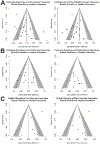The uncinate fasciculus in individuals with and at risk for bipolar disorder: A meta-analysis
- PMID: 34699854
- PMCID: PMC8631233
- DOI: 10.1016/j.jad.2021.10.045
The uncinate fasciculus in individuals with and at risk for bipolar disorder: A meta-analysis
Abstract
Background: Bipolar disorder (BD) is a severe mental disorder, characterized by prominent mood swings and emotion regulation (ER) deficits. The uncinate fasciculus (UF), a white matter tract connecting the amygdala and the ventral prefrontal cortex, has been implicated in ER. Aberrancies in UF microstructure may be an endophenotype associated with increased risk for BD. However, studies in individuals with BD and their first-degree relatives (REL) have yielded inconsistent findings. This meta-analysis takes a region-of-interest approach to consolidate the available evidence and elucidate the role of the UF in the risk-architecture of BD.
Methods: Using web-based search engines, we identified diffusion tensor imaging (DTI) studies focusing on the left and right UF and conducted meta-analyses comparing fractional anisotropy (FA) and radial diffusivity (RD) between BD or REL and healthy control participants (HC).
Results: We included 32 studies (nBD=1186, nREL=289, nHC=2315). Compared to HC, individuals with BD showed lower FA in the right (WMD=-0.31, p<0.0001) and left UF (WMD=-0.21, p = 0.010), and higher RD in the right UF (WMD=0.32, p = 0.009). We found no significant differences between REL and HC. In the right but not left UF, REL showed higher FA than BD (p = 0.043).
Conclusion: Our findings support aberrant UF microstructure, potentially related to alterations in myelination, as a mechanism, but not as an endophenotype of BD. However, given the limited power in the REL subsample, the latter finding must be considered preliminary. Studies examining the role of the UF in individuals at familial risk for BD are warranted.
Keywords: At-risk relatives; Bipolar disorder; Endophenotype; Uncinate fasciculus; White matter.
Copyright © 2021. Published by Elsevier B.V.
Conflict of interest statement
Declarations of interest
None.
Figures





References
-
- American Psychiatric Association. (2013). Diagnostic and Statistical Manual of Mental Disorders (DSM-5®). American Psychiatric Pub.
-
- Besenek M, Yilmaz IT, Guleryuz H, Guney SA, & Inal Emiroglu N (2019). Anterior cingulate cortex disconnectivity in high-risk offspring of bipolar patients: A preliminary DTI study. Dusunen Adam The Journal of Psychiatry and Neurological Sciences, 32(3), 203. 10.14744/DAJPNS.2019.00030 - DOI
Publication types
MeSH terms
Grants and funding
LinkOut - more resources
Full Text Sources
Medical
Miscellaneous

